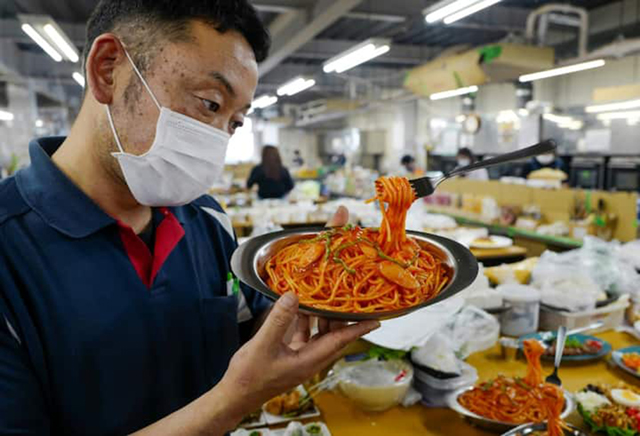TOKYO — From the “leaning tower of pizza” to a fish slicing and cooking itself and a dragon emerging from a dragon fruit, Japanese artisans’ quirky plastic food sculptures went on display this week at an exhibition in Tokyo.
The models were made with the same painstaking detail as the rock-solid noodle soups and crispy-looking plastic snacks that have long been displayed outside Japanese restaurants where they are called “shokuhin sampuru”, or “sample food products”.
Sampuru are common outside ramen shops and family restaurants across Japan a century after stores began using wax models to advertise their menu to a growing middle class.
“Normally we have to follow orders from clients. We take their views on board when we’re making items,” plastic food artist Shinichiro Hatasa, 57, told AFP.
But when dreaming up fun designs, “you can use your imagination. How it ends up is totally up to you,” he said.
For the exhibition, Hatasa crafted an ear of corn leisurely sunbathing on a beach.
Other creations on display included a deep-fried shrimp with four breaded legs roaming like a tiger on a mountain of shredded cabbage and a Tetris game made of chicken.
A Japanese breakfast dish of fermented soybeans called natto appeared to spiral in the air, resembling a powerful cyclone — nicknamed, naturally, a “nattornado”.
Around 60 sculptures were on display, some silly but others designed to showcase the artists’ formidable skills.
“They are not real, but they look so real. It’s wonderful,” said exhibition attendee Reiko Ichimaru.
‘Burgers are for beginners’
All the models were handmade by specialists at Iwasaki Group, Japan’s leading maker of “sampuru”, which celebrates its 90th anniversary this year.
At an Iwasaki factory in Yokohama near Tokyo, artisans first take moulds of ingredients from actual meals cooked by the firm’s restaurant clients.
Then they begin the meticulous work of decorating the samples to look as realistic as possible, from moisture droplets on chilled glass to subtle bruises on a fruit’s surface.
“Fresh things are more difficult to make. Fresh vegetables, fresh fish. Cooked items are easier,” because the colours are less complicated, factory head Hiroaki Miyazawa, 44, told AFP.
“Hamburger patties are for beginners,” he added.
Fake food is a multi-million-dollar market in Japan, but sampuru production has been hit by the COVID-19 pandemic, which reduced demand for dining out.
Sampuru makers hope more tourists will soon be allowed into the country to boost the restaurant industry, but they are also putting their unique skills to use elsewhere.
For example, Iwasaki artisans have made replica bananas at different degrees of ripeness for factories to use to train new employees.
Orders have also come in from IT sales merchants, who want to use mock 5G wi-fi routers in their presentations.
Meanwhile, at the exhibition, the more original offerings are delighting children and adults alike.
“I think the number of restaurants using plastic food displays is decreasing,” said Yutaka Nishio, 52.
“It’s interesting to preserve this as art. It’s really great.”
